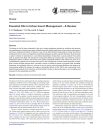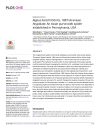Pavouk 54 (07/2023) 2023
- Autoři
- Mgr. Aleš Jelínek, Mgr. Antonín Roušar, Eva Legátová, Mgr. Jan Dolanský, Jan Erhart, Mgr. Karolína Čejková, MUDr. Kryštof Rückl, Nela Gloríková, Mgr. Ondřej Machač, Ph.D., Ondřej Vaněk, RNDr. Petr Dolejš, Ph.D.
- Abstrakt
- Pavoukovci České republiky; Pavučenka prstohlavá Dactylopisthes digiticeps (Simon, 1881) nalezena na území Česka; Křižák Gibbaranea ullrichi v Česku – jehla v kupce sena nalezena!; V čem tkví nenápadnost křižáka nenápadného?; Jak je to s výskytem křižáka trojlaločného (Cyclosa oculata) v Česku; Rodinný dům a pavouci (a sekáči); Vzácný nález v údolí řeky Bíliny v Krušných horách; Pozoruhodný nález populace slíďáka Pardosa morosa na Vysočině; Nečekané setkání; Pavouci, kteří mají (nejen) na růžích ustláno; Jedna pavučenka s očima, druhá bez očí (skoro); Mezinárodní arachnologická konference v Montevideu; Dvě červnové arachnoexkurze v Praze; Česká bibliografie; Inventarizační průzkumy 2022; Pokyny pro autory
Intense game grazing shapes epigeic spider communities of pedunculate oak Quercus robur plantations in anthropogenic environments 2023
- Autoři
- RNDr. Milan Řezáč, Ph.D., Nela Gloríková
- Abstrakt
Game browsing affects nature conservation because the interests of hunters and gamekeepers often lead to high game stocking rates. However, the compositional effects of game browsing on invertebrates are insufficiently understood. We addressed the dynamics of epigeic spider communities in oak stands planted in newly formed anthropogenic environments under the facultative pressure of browsing game. The study site consisted of an open-cast lignite mine and an overburden deposit in NW Czechia. Using pitfall traps, we examined five habitat types (four transects per habitat type): Quercus robur stands ≥ 25 years of age, 12–24 years of age, and 0–2 years of age; Q. robur stands 12–24 years of age that were heavily damaged by game browsing; and sites subject to spontaneous succession for 12–22 years. We captured 9459 individuals from 134 spider species distributed unevenly across the examined habitat types. The young stands were dominated by Pardosa agrestis, Pardosa monticola, and Oedothorax apicatus, whereas Pardosa prativaga, Pardosa lugubris, Pisaura mirabilis, and Alopecosa cuneata dominated the old stands. The stands damaged by browsing had the highest species richness and were dominated by Alopecosa pulverulenta, Xerolycosa miniata, A. cuneata, and Trochosa ruricola. All the oak stands were rich in threatened species, with most (26) found in habitats damaged by browsing, whereas the youngest stands hosted the lowest number of threatened species (11). The species dominating old stands still included species that prefer greater canopy openness, such as P. lugubris, whereas numerous species of central European climax oak forests were lacking. In conclusion, we identified oak stands heavily damaged by game browsing as a unique environment that shapes the community of epigeic spiders and that differs from epigeic spider communities of oak stands of various ages and those colonizing areas that are allowed to undergo spontaneous succession.
Food provisioning to Pardosa spiders decreases the levels of tissue-resident endosymbiotic bacteria 2023
- Autoři
- RNDr. Milan Řezáč, Ph.D., Nela Gloríková, Veronika Řezáčová
- Abstrakt
The diversity, host specificity, and physiological effects of endosymbiotic bacteria in spiders (Araneae) are poorly characterized. We used 16S rDNA sequencing to evaluate endosymbionts in the cephalothorax and legs of a wolf spider Pardosa agrestis. We tested the effects of feeding once or twice daily with fruit flies, aphids, or starved and compared them to those of syntopically occurring Pardosa palustris. The feeding increased traveled distance up to five times in some of the groups provisioned with food relative to the starved control. The Shannon diversity t-test revealed significant differences between these component communities of the two spider species. The increased frequency of feeding with fruit flies, but not aphids, increased the dominance and decreased the alpha diversity of OTUs. The obligate or facultative endosymbionts were present in all analyzed spider individuals and were represented mostly by Rickettsiella, Rhabdochlamydia, Spiroplasma, and the facultative intracellular parasite Legionella. Vertically transmitted endosymbionts were less common, represented by Wolbachia pipientis and Rickettsia sp. H820. The relative abundance of Mycoplasma spp. was negatively correlated with provisioned or killed aphids. In conclusion, the tissues of Pardosa spiders host tremendously diverse assemblages of bacteria, including obligate or facultative endosymbionts, with yet unknown phenotypic effects.
Diet affects the growth and behavior of Argiope bruennichi spiders and correlates with the species richness of their vertically and horizontally transmitted tissue-resident bacteria 2023
- Autoři
- Ivana Nagyová, RNDr. Milan Řezáč, Ph.D., Nela Gloríková, Veronika Řezáčová
- Abstrakt
The ability to spread and build quality webs is crucial to spider survival. These abilities may differ in response to dietary adjustments and changes in assemblages of tissue-resident bacteria, including vertically transmitted endosymbiotic taxa, particularly when expanding outside the native ranges. We measured the physical and behavioral parameters of the invasive wasp spider Argiope bruennichi subjected to four types of diets, including protein-rich and lipid-rich diets. We used 16S rDNA sequencing to evaluate vertically and horizontally transmitted tissue-resident bacteria, including endosymbionts, in the cephalothorax and legs of the tested spiders. The diet composition affected the body weight and carapace length as well as the locomotor parameters but not the orb-weaving abilities. Dietary treatments led to changes in the diversity and operational taxonomic unit (OTU) richness of facultative and obligate tissue endosymbionts, with Wolbachia and Rickettsia having higher relative abundance in spiders fed a lipid-rich diet. The higher OTU richness of facultative and obligate endosymbionts was associated with better locomotor performance. The other tissue-resident microbes were dominated by Firmicutes; the dominance and diversity of tissue-resident microbiomes also differed among spiders treated with different diets. The highest alpha diversity of tissue-resident microbes was present in spiders fed the standard diet, whereas all other diets led to a decrease in alpha diversity and various changes at the level of individual genera and OTUs. In conclusion, the tissues of A. bruennichi host tremendously diverse assemblages of bacteria, including obligate or facultative endosymbionts, which are sensitive to differences in diet composition and affect the locomotion of their hosts.
Pavouk 53 (12/2022) 2022
- Autoři
- Mgr. Antonín Roušar, Jan Erhart, MUDr. Kryštof Rückl, RNDr. Milan Řezáč, Ph.D., Nela Gloríková, Mgr. Ondřej Machač, Ph.D., Patrik Mlčoch, Šimon Petrov, prof. Mgr. Stanislav Pekár, Ph.D., Ing. Tomáš Hamřík, Viktor Střeštík, RNDr. Vlastimil Růžička, CSc.
- Abstrakt
- Pavouci České republiky; Pavučenka dlouhovlasá po dlouhé době!; Významné nálezy pavouků od Nových Mlýnů aneb najde ten, kdo nehledá; Můžeme v terénu či z fotografií spolehlivě rozeznat středoevropské křižáky rodu Zygiella?; Fenomén rekultivací v povrchových dolech pod Krušnými horami a výskyt pavouků; Výskyt pavučenky Staveleya pusilla (Menge, 1869) také v severozápadních Čechách; Dovolená s pavouky; Poznámka k výskytu sekáče Nemastoma bidentatum sparsum (Gruber & Martens, 1968) v Ohřeckém údolí; Inventarizace 2021; Výzva k spolupráci na World Spider Trait databáze; Kutilky (Sphecidae) – specialisté na lov pavouků XI: Sceliphron, Trypoxylon, Pison a Miscopus; Lumci bez křídel; Byli jsme na arachnologické konferenci v německém Greifswaldu!; Pozdně letní exkurze na Mostecko; 119. seminář České arachnologické společnosti; Česká bibliografie; Nové knihy; Pokyny pro autory
Contact exposure to neonicotinoid insecticides temporarily suppresses the locomotor activity of Pardosa lugubris agrobiont wolf spiders. 2022
- Autoři
- RNDr. Milan Řezáč, Ph.D., Nela Gloríková
- Abstrakt
Exposure to numerous chemicals disrupts the spiders’ locomotion. Spiders, particularly epigeic spiders, are dependent on their locomotory activities to search for prey, hide from their enemies, and perform sexual reproduction and subsequent parental care. Among the best-known compounds that inhibit the locomotion of arthropods are neonicotinoids. Despite spiders are less affected by the neonicotinoids than insects due to the sequence differences in their acetylcholine receptors, they are not resistant to these compounds. We hypothesized that acute exposure to a broad spectrum of neonicotinoids suppresses the traveled distance, mean velocity, and maximum velocity in epigeic spiders. As a model species, we used adults of Pardosa lugubris. We tested commercial formulations of thiamethoxam, acetamiprid, and thiacloprid. We tested each of the neonicotinoids in the maximum and minimum concentrations recommended for foliar applications. We applied them under controlled conditions dorsally by spraying them directly on the spiders or exposing the spiders to the tarsal contact with neonicotinoid residues. Control groups consisted of 31 individuals; treated groups consisted of 10–21 individuals. We found that a broad spectrum of neonicotinoids temporarily suppresses the traveled distance in epigeic spiders. At 1 h after application, all the three tested neonicotinoid insecticides induced declines in the traveled distance, but this effect mostly disappeared when tested at 24 h after the application. The decrease in the traveled distance was associated with substantial temporary decreases in the mean and maximum velocities. Despite differences among modalities, all three insecticides caused multiple adverse effects on the locomotory parameters in any tested concentrations. It remains to test what would be the lowest safe concentration for the chronic exposure to neonicotinoids in epigeic spiders.
Atypus karschi Dönitz, 1887 (Araneae: Atypidae): An Asian purse-web spider established in Pennsylvania, USA. 2022
- Autoři
- doc. RNDr. Jiří Král, Dr., Mgr. Martin Forman, RNDr. Milan Řezáč, Ph.D., Nela Gloríková, Veronika Řezáčová
- Abstrakt
The mygalomorph spiders of the family Atypidae are among the most archaic spiders. The genus Atypus Latreille, 1804 occurs in Eurasia and northern Africa, with a single enigmatic species, Atypus snetsingeri Sarno, 1973, known only from a small area in southeastern Pennsylvania in eastern USA. A close relationship to European species could be assumed based on geographic proximity, but A. snetsingeri more closely resembled Asian species. This study was undertaken to learn more about the genetics of A. snetsingeri, its habitat requirements and natural history. Molecular markers (CO1 sequences) were compared to available data for other atypids and showed that A. snetsingeri is identical with A. karschi Dönitz, 1887 native to East Asia. Natural history parameters in Pennsylvania were also similar in every respect to A. karschi in Japan, therefore, we propose that the spider is an introduced species and the specific epithet snetsingeri is relegated to a junior synonym of A. karschi. Cytogenetic analysis showed an X0 sex chromosome system (42 chromosomes in females, 41 in males) and we also detected nucleolus organizing regions and heterochromatin, the latter for the first time in the Atypoidea. In Pennsylvania the spider is found in a variety of habitats, from forests to suburban shrubbery, where the above-ground webs are usually attached vertically to trees, shrubs, or walls, although other webs are oriented horizontally near the ground. Prey include millipedes, snails, woodlice, carabid beetles and earthworms. Atypus karschi is the first known case of an introduced purse-web spider. It is rarely noticed but well-established within its range in southeastern Pennsylvania.










